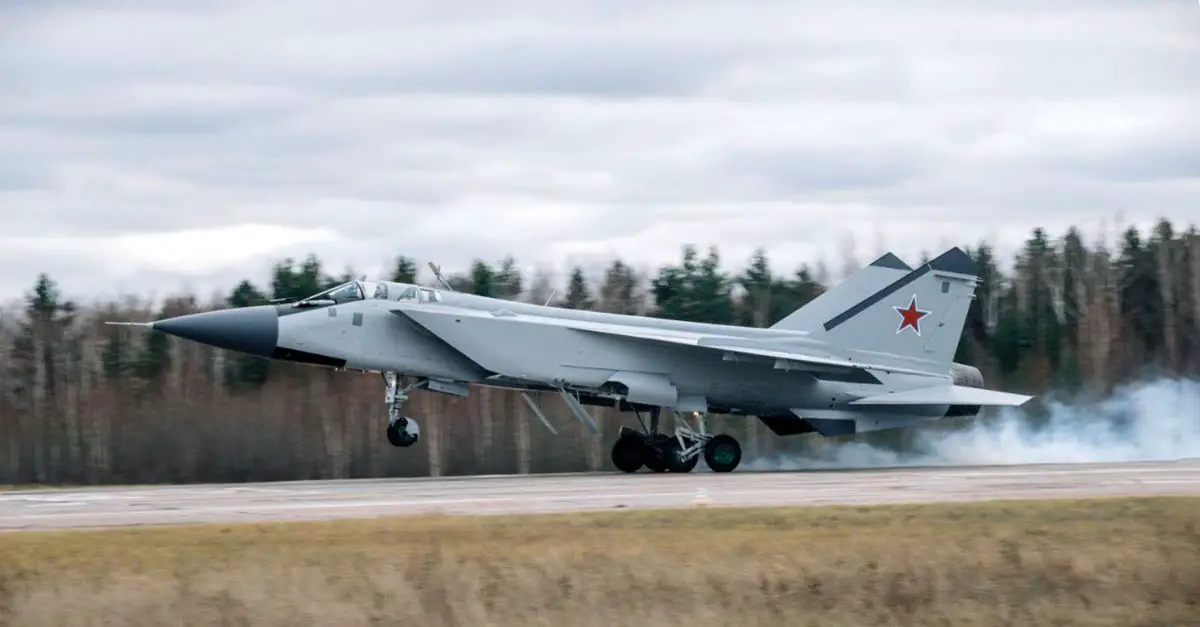Breaking News
Russian Air Force receives a new batch of modernized MiG-31BMs interceptors with long-range missiles.
On July 15, 2024, the United Aircraft Corporation (UAC) delivered the first batches of modernized MiG-31 aircraft to the Russian Ministry of Defense for the year, marking the first delivery of this model for 2024. Following a series of ground and flight tests that confirmed the specified requirements, the aircraft were sent to their permanent bases. The MiG-31BM has played a critical role in the conflict in Ukraine, with several confirmed shoot-downs of Ukrainian Su-25s and Su-24s.
Follow Army Recognition on Google News at this link

The MiG-31BM has played a critical role in the conflict in Ukraine, with several confirmed shoot-downs of Ukrainian Su-25s and Su-24s. (Picture source: UAC)
The aircraft were transferred by the Nizhny Novgorod aircraft plant "Sokol," a part of UAC, to the combat units of the Russian Aerospace Forces. The modernization at "Sokol" included upgrades to the weapons control system, onboard radar, and data exchange systems, aligning them with military standards MIL-STD-1553B and MIL-STD-1760. Additional enhancements included updating indicator equipment in the pilot and navigator operator cabins and installing a new terminal for tactical information exchange.
The MiG-31BMs undergoing modernization are regular MiG-31Bs that had been removed from storage and temporarily decommissioned. The core upgrade involves integrating the RP-31MA Zaslon-AM weapon control system with the 8BM radar, featuring a new Baget-55-06 onboard digital computer, replacing the older Argon-15A. This system enhances detection and tracking capabilities, with targets of 3 square meters detectable at 320 kilometers and automatic tracking at 280 kilometers. The system can simultaneously track 24 targets and engage six of them with missiles, an improvement from the previous version's capacity of ten and four, respectively.
Targets with a smaller effective reflection area and high speeds, such as those up to 1,000 meters per second, can be detected at 135 kilometers. Additionally, the R-37M ultra-long-range missiles, which have an interception range of maneuvering targets up to 230 kilometers, are now integrated into the aircraft's armament.
Measuring approximately 22.69 meters in length, 13.46 meters in wingspan, and 6.15 meters in height, the MiG-31BM is an updated variant of the Soviet-era MiG-31 Foxhound interceptor, developed to fulfill diverse roles beyond its original interception duties. Originally designed to replace the MiG-25 Foxbat, the MiG-31 entered service in the late 1970s, with over 500 units produced before production ceased in the 1990s. The MiG-31BM modernization program, which started in the 2000s, aims to extend the aircraft's service life and improve its operational capabilities for contemporary aerial warfare.

The MiG-31BM is an updated variant of the Soviet-era MiG-31 Foxhound interceptor, which entered service in the late 1970s, with over 500 units produced before production ceased in the 1990s. (Picture source: Army Recognition)
The MiG-31BM incorporates substantial modifications, including advanced avionics, a new multi-mode radar system, and an upgraded weapons control system. The Zaslon-M radar can detect targets up to 400 kilometers away and track 24 targets simultaneously. The cockpit has been upgraded with modern displays and digital data links. These improvements enable the MiG-31BM to undertake various missions, such as air-to-air and air-to-ground combat, reconnaissance, and suppression of enemy air defenses (SEAD).
Regarding combat capabilities, the MiG-31BM can carry various long-range air-to-air missiles, including R-33, R-37, and R-77 air-to-air missiles, and KH-31P, KH-58, and KH-59 anti-radiation and air-to-surface missiles. It is also capable of deploying the Kinzhal hypersonic missile, which can reach speeds of up to Mach 10 and target distances of up to 2,000 kilometers. Powered by two Soloviev D-30F6 afterburning turbofan engines, the MiG-31BM has a maximum speed of 3,000 km/h and a service ceiling of 20,600 meters. Its extensive range, bolstered by additional fuel tanks and mid-air refueling capabilities, allows it to quickly respond to potential threats and cover vast distances.
The MiG-31BM has played a significant role in the ongoing conflict in Ukraine, as the aircraft is now equipped with R-37M missiles, which can engage targets up to 300 kilometers away. This long-range capability has enabled the MiG-31BM to successfully intercept Ukrainian aircraft, including confirmed shoot-downs of Su-25 and Su-24 models. These interceptors have been stationed in strategic locations like Crimea and Belarus, enhancing Russia's air defense and offensive reach. Ukrainian pilots have had to adopt evasive maneuvers to counter this threat, although the MiG-31BM's speed, altitude, and missile technology have made it a challenging adversary. Despite some successful evasions, the MiG-31BM has remained effective in maintaining air superiority for Russia, complicating Ukrainian air operations.


























